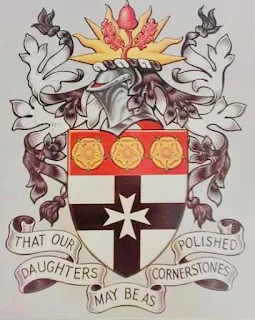 |
| The coat of arms of Tift College designed by Col. Harry D. Temple. Rendered by Chad Krouse, 2024 |
During the COVID-19 Pandemic I found myself going down deep research holes regarding US scholastic arms. One of the more interesting finds were the arms of Tift College which was located in Forsyth, Georgia. Tift closed in 1987 and absorbed by Mercer University, and at the time finding detailed information in Mercer's archives yielded little.
 |
| The armorial ensigns of Tift College in Forsyth, Georgia. |
I kept running into one major problem. Based on the best emblazonment of Tift's arms that I could find, the tincture for the chief remained unclear. Vert or azure, I wondered. I shared my data in the newly created Scholastic Heraldry group on Facebook in hopes that someone may have an answer. Well, things got even more confusing. My colleague from the American Heraldry Society, Joseph McMillan, shared an emblazonment he discovered in the files of the US Army's Institute of Heraldry--the rendering showed Gules for the chief. So, which was the final adopted version of Tift's arms? We agreed that without an official blazon for these arms we may likely never know.
 |
| Perhaps an early draft of Tift's arms, courtesy of Mr. Joseph McMillan. |
"Temple also designed 42 coats of arms in the National Cathedral in Washington and the coat of arms for the Virginia Tech Corps of Cadets, which was the first officially granted coat of arms from the Army to a unit outside the regular Army, National Guard, or Army Reserve. He shepherded it through the process to become officially registered with the U.S. Office of Heraldry. According to Temple's own estimates, he designed between 200 and 300 coats of arms for schools, colleges, and churches" (Cox, 2004).
 |
| Page snippet from Tift (1967) page 107. Click to enlarge. |
The following blazon for Tift College's arms is found on page 107 in Tift (1967), and from this document the chief's color is azure:
Shield: "Argent a cross sable with a maltese cross of the first, on a chief azure three roses or barbed vert."
Crest: "On a wreath argent and sable a rising sun or charged with a sprig of oak fructed azure" (107).
From the rationale, its interesting to note the use of the maltese cross to symbolize St. John the Baptist while alluding to the College's ties to the Georgia Baptist Convention. The golden roses in triplicate found on the blue chief represent three fundamentals espoused by the College: "development for usefulness in a democratic society, a high responsibility to establish the Christian family, a broad outlook for service" (Tift, 1967, 107). Moreover, the roses represent the State of Georgia's official flower, the Cherokee Rose, while symbolizing, "gracious and blossoming young womanhood" (Tift, 1967, 107).
Problem solved. Finding answers regarding corporate arms from closed institutions can be frustrating and rewarding at the same time. I am thankful for Mercer University's ongoing work to preserve Tift College's history and legacy in US higher education. As more documents are digitized and made accessible through the Internet, future discoveries--such as Tift's blazon--will add to our knowledge and understanding of the American heraldic tradition.
Works Cited
Cox, C. (2004 Feb 25). Designer of Nation's Presidential Medal of Freedom Dies. Virginia Tech News. https://news.vt.edu/articles/2004/02/2004-202.html
Tift College (1967). Chiaroscuro [yearbook]. The Chiaroscuro Collections, Special Collections and University Archives, Mercer University, Macon, GA. http://hdl.handle.net/10898/10928
Stone, E.W. (1969). Yesterday at Tift. Foote & Davies.
Wright, J.R. (2005 May 26). Heraldry of the American Episcopal Church [Lecture summary]. New York Genealogical and Biographical Society. https://silo.tips/download/heraldry-of-the-american-episcopal-church







0 comments:
Post a Comment